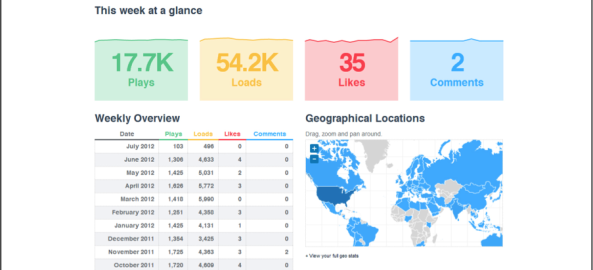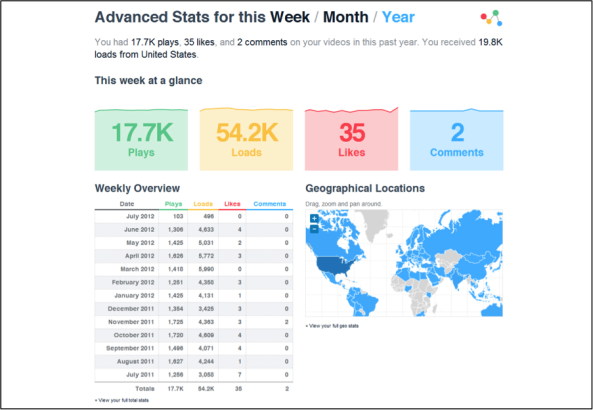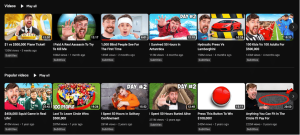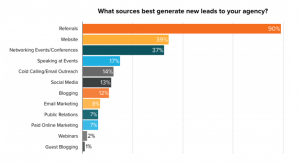So you’ve been writing fun blog posts, sending out e-newsletters, even sharing infographics through social media; but you’re missing a key piece: video marketing. More than blog posts, infographics or white papers, video is a game changer that can make a distinct emotional impact on potential customers.
How is video a game changer? It can tug at heartstrings, make you laugh and make you cry. It elicits powerful emotions in your audience and connects people with your brand. When people feel connected, they want to engage with you, share your content and ultimately, do business with you.
With all its emotional punch, video is a great way to tell your company’s story, educate your audience and offer unexpected value.
But, you’re probably scratching your head on how to start experimenting with video marketing AND how to make sure that you know it works. Just relying on the video view count on YouTube isn’t enough, you need proper tools combined with your automated marketing platform to track who’s watching and when.
With the following expert tips, you’ll ace video marketing campaigns easily and quickly!
Learn How to Narrowcast
Because not every video can score the kind of reach of a Super Bowl ad, you’ll want to learn how to narrowcast your brand message and focus on building the best video for your target market. The more specific your video, the better it’ll perform when it comes to conversions because it won’t be burdened by unqualified views or those who aren’t interested.
The first step in narrowcasting is understanding your niche. If you’ve got your target, you’ve got your focus. The next step is to find a creative way to package your video campaign to appeal to your niche.
Take a look at this above example from Cvent. The hilarious ad goes through a stressful scenario of planning a corporate event that every marketing event manager can relate to. The hook is that using Cvent will make event planning that much easier and help managers avoid drama. When you find a fun way to package your video campaign, your audience will respond to it.
The Lesson of Successful Narrowcasting
Weave your target audience’s everyday situations into your videos and showcase how your brand can solve their problems and make the scenario easier on your audience.
The best videos you can create are the ones where you talk directly to your niche about why you do what you do. The best story is when you focus not on selling, but talking to your audience about what inspires you, why you’re passionate about your industry and why you believe in what you do.
What’s your theme? Are you passionate about helping people connect? Do you make technology exciting or connect people to causes they care about? Find your overarching theme and find a way to effectively communicate it to your audience.
How do you know when your narrowcasting has been successful? When strangers who are unfamiliar with your brand can watch your videos and automatically identify with the people or profession the video is designed to cater to; you’ve nailed the narrowcasting approach.
Now that you have narrowcasting down, here’s 6 crucial steps on how to create a killer video campaign.
6 Steps to a Killer Video Marketing Campaign
1) Tie Your Video to a Clear CTA
Before writing a script, you must determine exactly what you want your audience to do after they finish watching your video. Do you want them to subscribe to your blog? Download a case study or simply go your website for more info? Always make sure you attach a clear call-to-action so your audience knows where to go next.
2) Figure Out How to Measure Your Video’s Performance
As you create more videos for a campaign, it’ll become more important for you to be able to determine whether a particular video was successful by measuring how videos are contributing to your sales pipeline.
To properly measure how successful your video is, make a list of 2-3 quantifiable objectives that you want your video to achieve. Maybe you want to collect a certain amount of leads with that particular video, have X amount of leads follow through on your CTA or increase your click through rate by X % by using video in email. Figuring out what your goal is will make writing the video content that much easier.
3) Craft a Compelling Story
Good storytelling in your videos can jumpstart your audience to take action. By eliciting a particular emotional response such as laughter, excitement or fear, you can motivate your audience to take action.
If you want to provoke laughter in your audience, you could try making a joke about your products, such as this funny ad from Kmart. It’s funny, shareable, relateable to most shoppers and there’s a product advantage within the message as well.
When you’re planning your video, start off by identifying how you want your audience to feel and how your story will create that emotion.
4) Build a Dedicated Landing Page & Make the Video the Star
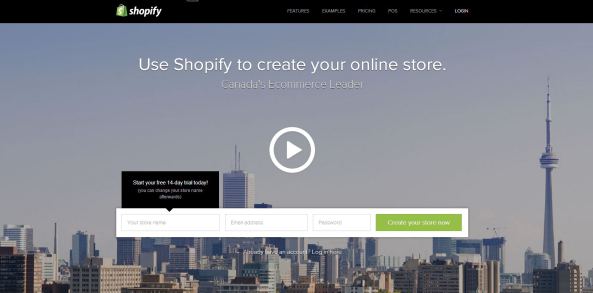
When you’re embedding a video into your website, it’s important to take visual impact into consideration. If you’ve built an entire video campaign, you’ll want to have a dedicated campaign landing page. The landing page can feature text-based content such as blog posts and white papers that evolve around your videos.
5) Track Quantifiable Video Data

After connecting your video to clear goals and releasing your content, look at video analytics to understand your performance.
Returning to the video goals you set up in step two, you should track the following metrics for your campaign on a daily basis for a set period of time (be it two weeks or longer):
• Average time spent on your dedicated landing page
• The click through rate on the landing page (what percentage of viewers clicked ‘play’)
• The video’s attention span rate (What percentage of viewers watch all the way through and when do viewers typically drop off?)
• The percentage of those who follow through with your end-of-video call to action
• The total amount of your video content leads consume (how many videos do individual leads watch in a day? A month? A week?)
• Which specific videos (or combos of videos) did converted leads watch?
• Click through rates on video thumbnails: Test out thumb¬nail images and identify which entices your audience to click and watch.
• Device type: What type of device are your viewers using to consume your video content? Consuming video on mobile is quite a bit different than on a desktop and this can influence how you package content. You’ll want to make sure campaigns are optimized for mobile if that’s where your audience hangs out.
• Geographic Location: Is your content relevant to the geographic demographic from which most of your viewers are watching?
6) Follow Up With Those Really Engaged
Finally, you’ll want to organize timely follow up with those who engaged with your video. If your video engagement data is connected to your marketing automation platform, you’ll be able to set triggers to notify you when leads watch a certain percentage of your video, or even send automated emails encouraging engaged leads to view more related content, connect with you on social channels and more.
Overall, use these six steps to run purposeful video campaigns and support major pillars of your brand messaging. If you find you’re always discussing a certain customer pain point, or using the same pitch to describe your services, scale your message with a memorable video story and – most importantly – track your success with meaningful metrics.
Using Video Through the Marketing Funnel

Now that you know how to narrowcast and create a great video campaign, the question remains: how do you know how many and what kind of videos to have on your site?
Video works to promote initial awareness of your brand when you post top-of-the-marketing-funnel ‘explainer’ videos that work to pique a viewer’s interest. Once a viewer’s interest has been piqued, the rest of your videos should focus on guiding viewers through the research phase. The research phase is your opportunity to prove to visitors your expertise in a chosen area, the usefulness of your products and the fact that your brand can solve their problems.
Here are the 3 Stages of the Marketing Funnel
The Interest Stage
During the attraction stage, you’re introducing strangers to your brand and there’s no better way to do that than with engaging video content.
Aside from the initial ‘explainer’ video, all your videos should focus on why you do what you do and not on your products. Why should people buy into your brand message?
Explainer Video
An explainer video should be your value proposition and keep it short and sweet to about 3 minutes.
Your “Why” Video
Illustrate your brand’s overarching story and help your customers do amazing things and most importantly, why you do what you do. It might not necessarily feature your products, but what it should feature is why you’re passionate about what you do, your industry and what differences you’re making in the world.
Thought Interviews Video
Capture one-on-one time with your company’s VPs, senior management and industry superstars. Content by influencers is widely shared and you can leverage their social networks.
Event Video
Create fun videos of your staff who are about to attend industry events and include a CTA for visitors to come meet you at the conference to initiate in-person meetings with your audience even before the conference starts.
Fun Company Culture Video
Show your quirky staff and ultimately show your audience why they should care about them.
The Learn Stage (How-To Content)
High-level product reviews, how-to videos, repurposed recorded webinars and other educational pieces are part of the strategy at this stage. You’ll have a chance to convert visitors to marketing qualified leads by using email gating features to collect customer data and drive them to your website. Great content for this stage includes:
How-to Video Libraries
Showcase your expertise with how-to videos, they will give you the upper hand when it comes to searches
Recorded Webinar Content
Record your webinars and break them down by topic so viewers can find them easier.
Product Tour Videos
Give visitors a high-level overview of your products & solutions. If you map the path out into 4 or 5 videos, each one can lead to the next and you can gauge how engaged your visitors are by how much of the path they engage in.
The Extra Post-Sale Stage
If someone posts a frequently asked support question, for example, consider creating a video to answer it and sharing it via social media. Let customers know their questions are appreciated, answer the question and showcase your support staff.
Once a customer has opted in to your email campaigns, consider sending them a thank you video from all your staff. Not only will customers have a friendly group to turn to if they have an issue, they’ll know you care enough to make something personal.
Thanks for reading Part 1 on how to make the most out of your video marketing! Stay tuned for Part 2 on how to combine video with marketing automation, coming soon!
Business Articles | Business 2 Community
(388)
Report Post